relaxation - Have managed to get some down time. Stop off's whilst going South.
Have managed to get some down time. Stop off's whilst going South. Break up the 500 mile journey, seeing friends, on occasions going to the odd funeral.
Recently stopped off in Carlisle to say goodbye to Pat Hannan. A wonderful service in the Cathedral and a get together with old Carlisle friends. Then it was a dash down to see Gwen.
Within a couple of weeks we had to go down to Carlisle again on business, but took the advantage of staying overnight prior to our meeting. So we stopped off for a walk in Annan. It was a glorious day and a great walk, very interesting.
Judith had to go into Glasgow for a health check so we took advantage and stayed over for a couple of nights.
Took the local Dunoon bus in that bordered the ferry and then took us into the centre of Glasgow. Effortless, not luxury, but great relaxation and no driving or having to find parking.
Crammed a lot into the couple of days in the West End. Some fantastic restaurants, plus a great walk into Kelvingrove Park, then onto the Botanical gardens for a bacon butty and a good pot of tea. Then walked further on until we managed to get to the canal before returning to the museum.
Kelvingrove Art Gallery and Museum houses one of Europe's great art collections, plus it has an organ recital at midday. Great entertainment before roaming all the galleries.
After which we headed to see a movie at Cineworld,
floors and floors of different screens. And ours was scarily on the 55th
floor, or it felt like it. To watch Guardians of the Galaxy Vol. 2. Brilliant
film.
The film was truly magnificent, if you like
sci-fi movies blended with action and tongue in cheek humour, dotted with an
array of famous stars in ludicrous cameo roles. We had only recently seen the
original and were bold over with its humour. So the chance to see a sequel on a
big screen could not be missed.
The only down side is having to share the movie with other individuals. Especially those that crunch through bags and bags of pop corn whilst you are try to listen to the storyline. If its not the crunching its the snorting, coughing and spluttering. Germs flying everywhere. Judith managed to get a girl with a bouffant hair style, bouncing up and down on top of her boyfriend. Or so it seems. Whilst other viewers couldn't sit still for five minutes before they climb over their neighbours to go to the loo or buy even more popcorn.
Following day we went down to the river to the Riverside Museum, home to some of the world’s finest cars, bicycles, ship models, trams and locomotives. And a great and interesting interactive Glasgow street scene. Brings all the objects and stories to life, excellent.
Excellent pub, great atmosphere, The Horseshoe Bar
Characterful pub with captivating decor, horse sculptures, Roman painted tiles and grand island bar. Drury St, Glasgow G2 5AE


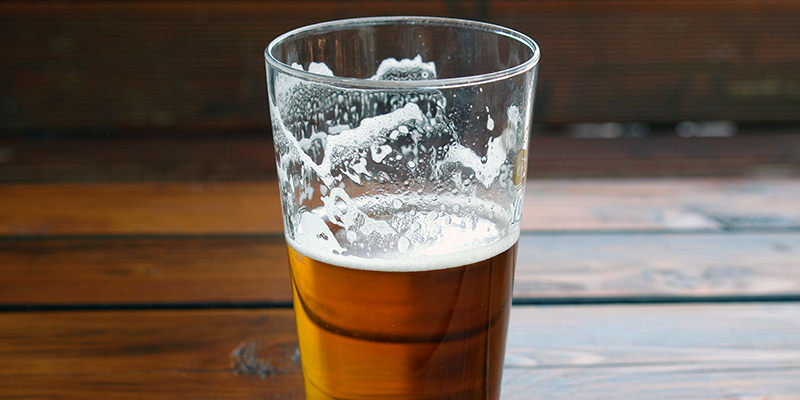
 Even before Sustrans had opened the Glasgow-Loch Lomond cycle track, I
had discovered a route that did just that. By pedalling, or walking
along the Kelvin Walkway and linking up with the Forth and Clyde Canal
towpath at the Kelvin Aqueduct, it was possible to organise an outing
with only one brief crossing of a public road.
Even before Sustrans had opened the Glasgow-Loch Lomond cycle track, I
had discovered a route that did just that. By pedalling, or walking
along the Kelvin Walkway and linking up with the Forth and Clyde Canal
towpath at the Kelvin Aqueduct, it was possible to organise an outing
with only one brief crossing of a public road.
 After crossing Kelvingrove Park, the route then leads under Kelvin
Bridge, on past a ruined grain mill and behind the BBC Scotland
headquarters in Queen Margaret Drive. Then, after flanking the Botanic
Gardens, it emerges behind the old Maryhill Barracks, and soon arrives
at Scotland's Pont du Gard, the Kelvin Aqueduct. A miracle of the 18th
century engineering and architecture, this was in its day the largest
functioning aqueduct in Europe, and a major tourist attraction. It
practically bankrupted the Forth and Clyde Canal Company, and held up
work for seven years. it is 400 ft long and stands 75 ft high on four
graceful arches, the masterpiece of the engineer Robert Whitworth, who,
replaced John Smeaton as chief engineer on the canal.
After crossing Kelvingrove Park, the route then leads under Kelvin
Bridge, on past a ruined grain mill and behind the BBC Scotland
headquarters in Queen Margaret Drive. Then, after flanking the Botanic
Gardens, it emerges behind the old Maryhill Barracks, and soon arrives
at Scotland's Pont du Gard, the Kelvin Aqueduct. A miracle of the 18th
century engineering and architecture, this was in its day the largest
functioning aqueduct in Europe, and a major tourist attraction. It
practically bankrupted the Forth and Clyde Canal Company, and held up
work for seven years. it is 400 ft long and stands 75 ft high on four
graceful arches, the masterpiece of the engineer Robert Whitworth, who,
replaced John Smeaton as chief engineer on the canal.
 The Clyde Navigation Trust, whose huge satanic granary, the largest
brick building in Glasgow, now lies empty, Barclay Curle's engine works,
with German-influenced steel and glass frame and mansard roof and the
site of Albion Motors, part-demolished. And now the cyclist dodges
between those who worked - or probably, whose fathers worked - in the
abandoned factories, walking their rotweillers and alsatians, drinking
in quiet knots at 8a.m.
The Clyde Navigation Trust, whose huge satanic granary, the largest
brick building in Glasgow, now lies empty, Barclay Curle's engine works,
with German-influenced steel and glass frame and mansard roof and the
site of Albion Motors, part-demolished. And now the cyclist dodges
between those who worked - or probably, whose fathers worked - in the
abandoned factories, walking their rotweillers and alsatians, drinking
in quiet knots at 8a.m.
Recently stopped off in Carlisle to say goodbye to Pat Hannan. A wonderful service in the Cathedral and a get together with old Carlisle friends. Then it was a dash down to see Gwen.
Within a couple of weeks we had to go down to Carlisle again on business, but took the advantage of staying overnight prior to our meeting. So we stopped off for a walk in Annan. It was a glorious day and a great walk, very interesting.
Judith had to go into Glasgow for a health check so we took advantage and stayed over for a couple of nights.
Took the local Dunoon bus in that bordered the ferry and then took us into the centre of Glasgow. Effortless, not luxury, but great relaxation and no driving or having to find parking.
Crammed a lot into the couple of days in the West End. Some fantastic restaurants, plus a great walk into Kelvingrove Park, then onto the Botanical gardens for a bacon butty and a good pot of tea. Then walked further on until we managed to get to the canal before returning to the museum.
Kelvingrove Art Gallery and Museum houses one of Europe's great art collections, plus it has an organ recital at midday. Great entertainment before roaming all the galleries.
Early tea at Bread meets Bread, winner of Scotland's Best
Burger of 2016
 |
| View from the top of the cinema |
The only down side is having to share the movie with other individuals. Especially those that crunch through bags and bags of pop corn whilst you are try to listen to the storyline. If its not the crunching its the snorting, coughing and spluttering. Germs flying everywhere. Judith managed to get a girl with a bouffant hair style, bouncing up and down on top of her boyfriend. Or so it seems. Whilst other viewers couldn't sit still for five minutes before they climb over their neighbours to go to the loo or buy even more popcorn.
Following day we went down to the river to the Riverside Museum, home to some of the world’s finest cars, bicycles, ship models, trams and locomotives. And a great and interesting interactive Glasgow street scene. Brings all the objects and stories to life, excellent.
Characterful pub with captivating decor, horse sculptures, Roman painted tiles and grand island bar. Drury St, Glasgow G2 5AE

Ian Mitchell, local Westender, writer, historian and fan of the great outdoors, has provided information which will interest those of you who like to get out and about and really stretch your legs:
A Circular Cycle/Walk from Kelvingrove Park.
The pressure generated for the creation of designated cycle tracks in
Scotland is, to a large extent, the work of Sustrans, a charity which
has negotated, promoted and built many miles of them in England, Wales
and Scotland. Most of the tracks have been constructed on abandoned
railways and canal paths, and there is a plentiful supply of both in the
Glasgow region - several of which pass through the West End.
(The centre of Glasgow is being connected to Kelvingrove Park by an
extension of the Cycle Track network).
The biggest, and so far the best, cycle track is that from Glasgow to
Loch Lomond and the first stage of the Glasgow-Edinburgh link is now
open - between Bathgate and Airdrie. The existing routes are very
enjoyable and not only do they take you away from the fumes and danger
of cycling on roads congested by traffic, but because they also often
take you deep into Glasgow's industrial history.
The first route starts in Kelvingrove Park, near the fountain erected by
the grateful citizens of Glasgow to the man who brought them pure water
in lead pipes from Loch Katrine, Provost Stewart. Sadly, the purity of
the water means that unhealthy quantities of the lead can be found in
the bodies of the city's inhabitants. The fountain dates from 1872 and
can be viewed as a monument to error and the contradictions of progress.
A pech uphill to join the canal bank from the walkway, shows the Kelvin
Dock, where many of the canal's boats were built. The tow path eases the
journey to Clydebank. Along the canal went the grain, iron ore and
textiles of the first phase of Scotland's industrial revolution.. Heavy
engineering replaced textiles as Glasgow's main industry, and the Clyde
replaced the canal as the city's main link with the world.
Safe and fee from traffic, this route shows the post-industrial city as a
nature reserve. both tow-path and walkway are fringed thickly with
trees and shrubs, and I've seen herons fishing behind BBC Scotland
headquarters, watched squirrels at Kelvindale and disturbed a fox at
Westerton. In spring the canal is the nesting place of swans and coots,
in autumn the haunt of berry-pickers, and year round the beat of
apparently luckless anglers, though I have seen the more favoured
occasionally pull a stunted pike from the murky depths of the waters.
And of course the more traditional Glasgow flora and fauna of old
bedsteads, abandoned cars and drunks are also encountered. At the moment
the canal is largely dried out and there is a lot of restoration work
going on and all the rubbish is being thankfully cleared away.
Although not an "official" cycle track, the artery of Scotland's first
industrial revolution is widely used by cyclists, and it joins the
official Glasgow to Loch Lomond cycle track at Clydebank Shopping
Centre. By combining the two routes in either direction, a round trip of
about 14 miles gives a couple of hours' cycling or five hours walking.
This Glasgow to Loch Lomond track, which was opened in 1989, can be a
bit difficult to track down, but access can be got from a subterranean
passage beside the former Partick Fire Station, now converted into
flats. The track follows the course of an old railway, and thus the
gradients are always mild. This, with the tarred surface, makes it easy
going. The views south across the Clyde, and north to Kilpatrick Hills
are fine, but the cycle track is less vegetated than the canal path, and
thus supports less wildlife, although I did once see a kestrel hovering
over the track.
But for foot or pedal powered industrial archeologists, the track is a
dream, a vantage point to the deindustrialisation of Glasgow. Amid the
pockets of yuppification - the odd block of smart flats, a marina - are
miles of abandoned shipyards, factories, dockyards, whose names read
like a litany of Glasgow's lost greatness.
The Kelvin Walkway and the Forth and Clyde Canal towpath have attracted a
wide variety of users, apart from cyclists. In addition to the legions
of joggers, one can see climbers practising their arts on the Kelvin
Bridge, and even occasionally canoeists shooting the Kelvin rapids.
Along with this usage has come the provision of decent watering places.
You can stop for a pint of real ale at the Lock 27 on the canal at
Anniesland, or have yourself a coffee and croissant at The Big Blue,
under Kelvin Bridge.
No such establishments have as yet attached themselves to the cycle
track, for apart from the cyclists, it is mainly used by the locals as a
dog walking path, or as a route to their pigeon lofts. Nevertheless,
since it takes you through a part of Glasgow that is by no means miles
better, it should be visited by anyone who wants a completer picture of
life there.
Those of you who are really fit and adventurous may want to carry on
further- From Clydebank you can move back onto the towpath of the Forth
and Clyde Canal and cycle past Old Kilpatrick, under the Erskine Bridge
to Bowling and then Dumbarton. Once through Dumbarton, the route follows
the banks of the Leven to Balloch and Loch Lomond. If you go this far
it is reassuring to know that you can always get the train back to the
Westend.
Ian Mitchell.
Details of cycle paths in Scotland can be obtained from Sustrans at 53 Cochrane Street, Glasgow G1 1HL. Telephone: 552 8241.
Copyright I.R. Mitchell
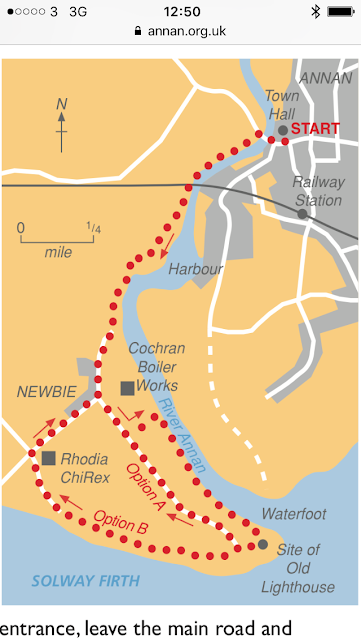







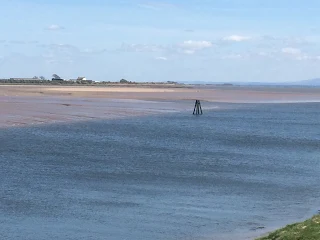


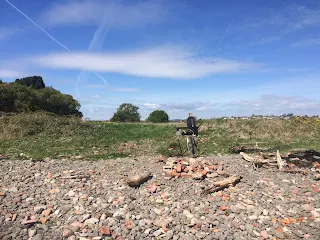










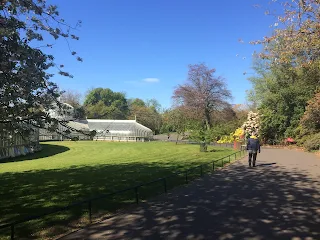



























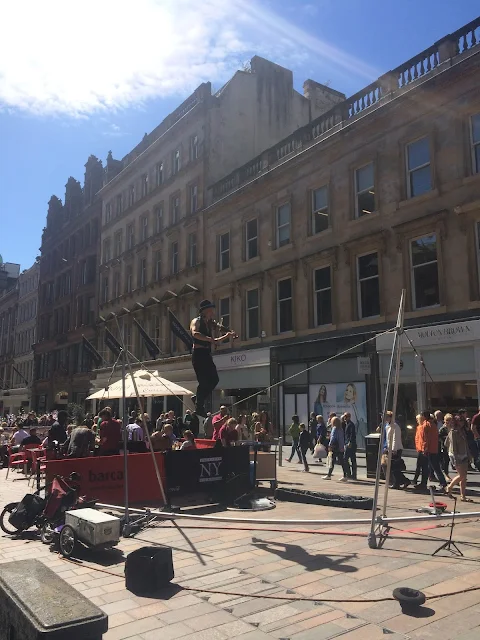

Comments
Post a Comment